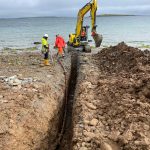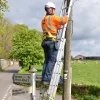2024 H2 – UK Coverage of Gigabit Broadband Nears 86 Percent

ISPreview has today published our biannual UK summary of fixed broadband coverage for H2 2024, which found that “full fibre” (FTTP) ISP networks have grown to reach 73.53% of premises (up from 67.68% in H1) and 85.87% are within reach of “gigabit” speeds (up from 83.39%). Continue on to see details for England, Wales, Scotland and N.Ireland.
Just to recap. Virtually all the new gigabit-capable (1000Mbps+ or 1Gbps+) connectivity added during 2024 has come from Fibre-to-the-Premises (FTTP) based networks via Openreach (BT), Nexfibre (Virgin Media), Hyperoptic, CityFibre, Netomnia (YouFibre), KCOM, Gigaclear and many other alternative networks (Summary of Full Fibre Builds).
The reason why “gigabit” coverage is currently still higher than FTTP is down to the 14.3 million premises covered by Virgin Media’s older Hybrid Fibre Coax (HFC) network, which uses gigabit-capable DOCSIS 3.1 technology (there’s a lot of FTTP overbuild with this in urban areas).
Advertisement
In addition, most of the progress on gigabit-capable builds during 2024 is still down to commercial investment in FTTP (commercial builds have already delivered the first 80%+ of gigabit cover), often with only a little support from the Government’s various voucher schemes. But the £5bn Project Gigabit scheme and its subsidised rollouts are starting to have an impact on this, albeit focused on the hardest to reach premises (e.g. rural) that typically take longer to cover.
H2 2024 Broadband Coverage Figures
Listed below is the latest independent modelling from Thinkbroadband for early January 2025 (H2 – 2024). We should point out that the figure for ‘Under 10Mbps‘ doesn’t reflect 4G mobile coverage (we only look at fixed line broadband), which plays a part in the official Universal Service Obligation (USO) but isn’t included in TBB’s mapping. Sadly, it’s incredibly difficult to do an accurate model for mobile coverage, especially in terms of a specific performance level.
Fixed Broadband Network Availability H2 – 2024
| Area | 30Mbps+ | Full Fibre | Gigabit | % Under 10Mbps |
| England | 98.42% (98.24%) | 73.63% (67.41%) | 86.66% (84.15%) | 0.53% (0.59%) |
| UK | 98.22% (98.01%) | 73.53% (67.68%) | 85.87% (83.39%) |
0.70% (0.79%) |
| Wales | 97.42% (97.04%) | 73.13% (67.38%) | 77.72% (73.65%) | 1.43% (1.60%) |
| Scotland | 96.73% (96.31%) | 65.49% (61.33%) | 79.62% (77.64%) | 1.84% (2.09%) |
| N.Ireland | 98.61% (98.29%) | 96.06% (95.19%) | 96.46% (95.73%) | 0.76% (0.98%) |
NOTE: It’s very important to remember that Government / political coverage targets, like the previous “85%” for gigabit by 2025, reflect a national average, which can of course be better or worse for some areas (e.g. some counties may achieve higher coverage, while others could be well below that).
Take note that each region (Scotland, Wales etc.) may also have its own policy and targets, which will feed into the central UK coverage figure. Furthermore, it’s worth highlighting how much of an impact newer alternative networks (altnets) are having on all this – excluding coverage by Openreach, KCOM (Hull) and Virgin Media.
Advertisement
Rival altnets were found to have covered 39.38% of the UK with FTTP by the end of H2 2024 (up from 35.28% in H1). This breaks down as 41.50% in England (up from 37.16%), just 16.89% in Wales (up from 14.23%), 32.05% in Scotland (up from 29.71%) and 39.29% in Northern Ireland (up from 34.44%). But the overall coverage improvement delivered from this will be reduced due to overbuild between so many networks, particularly in urban areas.
As stated earlier, this data is an estimate and should be taken with a pinch of salt, not least because it won’t always reflect the very latest real-world position. But it’s still one of the best and most up-to-date gauges that we have for checking against official claims (Ofcom’s own data tends to be several months behind that of TBB’s).
Solutions for Slow Broadband Areas
Finally, those still stuck in sub-10Mbps speed areas will, at least for now, be left with little option but to try harnessing the flawed 10Mbps Universal Service Obligation (USO) via BT (UK-wide) or KCOM (Hull-only). Many of those who have pursued the USO say they were offered a mobile broadband (4G or 5G) connection via EE, but those considered delivered under the USO itself usually get full fibre (FTTP) lines.
However, the reality is that some people will find they live in areas where not even the USO can cover the colossal upgrade costs of getting FTTP (here and here). The government are currently still examining support options for remote premises and are also preparing to review the broadband USO (here), which may bring some changes in the future, particularly with the new change in leadership (here).
Advertisement
Failing that, consumers could either try waiting to see if the problem gets resolved or consider exploring the option of a LEO satellite service (Starlink is good, if you can afford it). We would also recommend that consumers check via Three UK, Vodafone and O2 (VMO2) to see if any of those deliver better 4G or 5G mobile coverage than EE in your area (ideally by conducting your own tests, since official coverage maps are fairly useless) – see our guide to external antennas.
Mark is a professional technology writer, IT consultant and computer engineer from Dorset (England), he also founded ISPreview in 1999 and enjoys analysing the latest telecoms and broadband developments. Find me on X (Twitter), Mastodon, Facebook, BlueSky, Threads.net and Linkedin.
« INCA CEO Talks Future of UK Broadband Altnets and Infrastructure Sharing






















































I believe VMED O2 have now started to sell services over their own upgraded XGSPON fibre network. Unlikely to make a difference to fibre coverage, but will be interesting to see what levels of penetration they achieve given overbuild.
I’d avoid that company at all cost……..
Just out to destroy your credit ratings when you try to leave…..
Fact
The full fiber coverage in Scotland is terrible outside of the biggest towns and cities and we’re not just worst in the UK but the gap is getting wider year or year. Proper action from the UK and Scottish government is needed to catch up
Judging from the situation round here “remote” premises include those on the opposite side of the road from the poles carrying the fibre.
Yes or like in my area where the cables are buried directly in the ground “DIG”. Apparently too much trouble to fix.
So Openreach are planning to reach 25 million premises passed by the end of 2026, i.e. about 8 million more in the next two years. Nexfibre are planning to reach 5 million by the end of 2026, (around 3 million more I believe) and Netomnia aim to reach 3 million premises by the end of 2025 (around 2 million more maybe). Then there are various BDUK contracts too. That’s a lot of FTTP in the next two years.
Well, here in Tadley (Hants), Nexfibre seem to have completed their build, OR have done absolutely nothing and their build plan doesn’t look promising until end-2026, Giganet are extinct without connecting more than a handful of properties. So our road in a ‘rural’ bit of Tadley remains outside anyone’s build plans for the next few years it seems, and of course none of these fibre providers will respond to a straight query of ‘are you planning to build FTTP in our road and if so, when?’. So Gerarda and Richard S, you’re not alone, it seems like these companies are let off the hook for properties which are a lower return on investment…
Nope, Project Gigabit still not interested in rural Kent. Not single houses, or hamlets but villages of many thousand people are of no consequence.
What a failure…
That is utter rubbish, where i live in higham us on the main Gravesend road are not getting any fttp at all and I have been pestering trooli who falsely claim they cover all of higham when they don’t.
Honestly the entire facade of the Government having anything to do with Broadband is a joke. Their Quarterly Updates come biannually at best & any estimates they seem to publish in relation to contract award dates seem to be regularly delayed but 12 or more months if they even get awarded at all. I’m at the point where I’m even dubious they’ll hit their diminished targets by 2030. I’d say that the data transmission offered by Royal mail was more effective except they’ve gone to the wall as well.
Why not compare in rural areas where fttp is still poor. Really, I am fortunate enough to get symmetrical 940 down -up. But what about the villages who still get poor BB?
Or are their needs nothing to the providers??
We were missed by Zzoomm and OR have delayed our upgrades to fibre until July 2026 even though we are now longer in their build plans when we were originally down for this year.
No other altnet in our area to provide full fibre and I guess this is similar to a lot of other areas so how can they say they have some much coverage for these speeds, are they based just on urban areas and close proximity to the centres?
No, it’s based on the entire UK population.
Virgin’s network reaches most of the UK. Ooenreach’s FTTP is available to millions of homes, altnets too.
Missing a few homes in a town somewhere doesn’t change the overall number – in fact it tends to suggest that it’s true.
There is clearly still work to do, and it will be ever harder and more expensive to do it but the pace of improvement over the last 5 years has been remarkable. I didn’t think the incumbents would have it in them to do it.
Fair play! 😀
I’m one of the unlucky 13% that can get Gigabit (i.e. Virgin) but not full fibre. I could understand if I lived in a rural area untouched by modern life or a deprived town beset by difficulties but no I live in a pretty nice part of suburban London